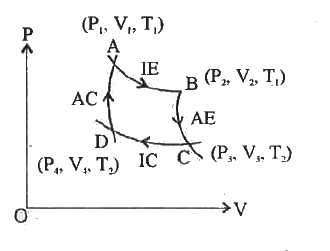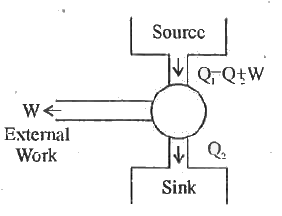Explain the working of Carnot's heat engine with the help of graph.
Text Solution
Working of Carnot.s engine :
Step 1 : The working substance (ideal gas) is enclosed in a non-conducting wall and conducting bottom of a cylinder fitted with air tight non conducting piston. This is placed on the source having an infinite thermal capacity at a steady temperature. The top surface is conducting and the rest non conducting. As a result, the gas expands isothermally. The work done by the system,
W1=μRT1logV2V1 (Curve A B)
Step 2 : The working substance is now placed on a non conducting platform, as a result of which no heat exchange takes place between the system and the surroundings. The system expands adiabatically at the expense of its internal energye. The gas cools. The work done by the system,
W2=μRγ−1(T1−T2) (Curve B C)

Step 3 : The working substance is now placed on the sink maintained at a steady low temperature T2K. The symstem undergoes isothermal compression at this temperature. The pressure of gas increases and volume decreases without any chagne in the internal energy and specific heat of gas remains at infinity.
W3=μRT2log(V4V3) (Curve C A)
Step 4 : The working substance is placed on a non-conducting platform. Under thermal isolation, the system undergoes Extermal change in its intcrnal energy and its specific heat remains at Work zero. Adiabatic compression results in increase in the presssure and temperature at the expense of work being done on the
For η1=η2,T1T2=T11T12andQ1Q2=Q11Q12.
For refrigerators (reverse Carnot.s engine)
coefficient of performance β=Q2W=Q2Q1−Q2
W- Work done on the system.
Q2- Heat extracted from the cold reservoir
Q1- Heat rejected to the surrounding.
Coefficient of linear expansion α=(change in length)(original length)(rise in temperature)
i.e., α=(l2−l2)l1(θ2−θ1)K−1
Coefficient of superficial expansion β=2α=ΔAA(θ2−θ1)K−1
Coefficient of volume expansion γ=3α=ΔVV(θ2−θ1)K−1
First Law of Thermodynamies, dQ=dU+dW.
Q=msθ, where s=QmθJkg−1K−
Thermal capacity of a substance =(ms)JK−1
CP−CV=RandCP−CV=r
dS=dQT where dS = change in entropy
T= steady transition temperature.
Classius - Clapeyron equation,
dPdT=LT(V2−V1) where L- latent heat rate of change of pressure with temperature per kg of substance.
For V2>V1 as in the transition of liquid state to gasesous state, implies that increase of pressure increases the boiling point of liquids.
For V2<V1 as in the case of melting of ice (water like substances)
V2−V1−veand(dPdT) is negative.
This implies increase of pressure decreases the freezing point of liquide below 0∘C. For V2−V1=+ve (wax like substances), increase of pressure increases the melting poin of solids.
Expressions for adiabatic processes:
P1Vγ1=P2Vγ2
T1Vγ−11=T2Vγ−12.
T1P11−γγ=T2V21−γγorT=KPγ−1γ
Vander Waal equation for real gases:
(P+μ2aV2)(V−μb)=μRT
where μ= number of moles
V= volume of the container
μb= volume of μ moles of gas
μ2aV2 = pressure due to intermolecular collisions.
Coefficient of performance of Carnot refrigerator,
β=Q2Q1−Q2=Q2W=Heat extracted from cold reservoirWork done by compressor motor

|
Topper's Solved these Questions
- THERMODYNAMICSBook:SUBHASH PUBLICATIONChapter:THERMODYNAMICSExercise:NUMERICALS WITH SOLUTIONS
Explore 24 Videos
- THERMODYNAMICSBook:SUBHASH PUBLICATIONChapter:THERMODYNAMICSExercise:THREE MARK QUESTIONS AND ANSWERS
Explore 3 Videos
- THERMAL PROPERTIES OF MATTERBook:SUBHASH PUBLICATIONChapter:THERMAL PROPERTIES OF MATTERExercise:FOUR MARKS QUESTIONS AND ANSWERS
Explore 22 Videos
- UNITS AND MEASUREMENTS Book:SUBHASH PUBLICATIONChapter:UNITS AND MEASUREMENTS Exercise:NUMERICALS WITH SOLUTIONS
Explore 13 Videos
Similar Questions
Knowledge Check
The efficiency of a Carnot heat engine
Ais independent of the temperature of the source and the sinkBis independent of the working substanceCcan be 10%Din not affected by the thermal capacity of the source of the sinkEfficiency of a Carnot heat engine may be given as
AwQ2B1−Q2Q1C1−T1T2DNone of theseThe temperature of the source of Carnot's heat engine is T1, and that of sink is T2 having efficienty 0.5. The efficiency of another Carnot's heat engine is also 0.5. The temperature of source and sink of the second engine are respectively.
A2T1,2T2B2T1,T22CT1+5,T2−5DT1+10,T2−10
Find the efficiency of a Carnot's engine working between 127∘C and 27∘C.
View SolutionFor which combination of working temperature, the efficiency of Carnot's engine is the least ?
View SolutionThe efficiency of carnot's heat engine is 0.5 when the temperature of the source is T1 and that of sink is T2 .The efficiency of another carnot's heat engine is also 0.5.the temperature of source and sink of the second engine are respecitvely
View SolutionFind the efficiency of a Carnot's engine working between 127∘Cand27∘C ?
View SolutionFor which combination of working temperature, the efficiency of Carnot's engine is the least ?
View Solution

